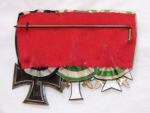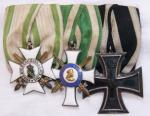-
Posts
2,947 -
Joined
-
Last visited
-
Days Won
11
Content Type
Profiles
Forums
Blogs
Gallery
Events
Store
Everything posted by Claudius
-
Thank you Rick. I can't find anything on him after the war either. I know he was alive to get the Hindenburg cross and some circumstantial evidence to show he was alive in 1938. I was hoping he found a naval job with rank in the TR and therefore be registered somewhere. (at his age, a desk job) While I know where he was from 10/1916 to 1920, I don't know where/when he was born and when he died or where he was buried. Chip: Thank you for the further info on the insignia. I have seen the cloth badges around and noticed differences in manufacturing, but I didn't realize they were private purchases for their wool jumpers.
-
Paul Kutzner of U-boot UC-20. UC-20 was a mine-laying type sub, but early on had her mine laying tubes removed and the space was used for a cargo hold. It ran arms and munitions transport missions in the Mediterranean Sea. It's the "famous" uboot that carried a young camel as a gift back from North Africa to the sub base at Pola.
-
Great! The sailor I am examining was a Oberbootsmannmaat (9/1916). I was told the rank was similar to a Chief Boatswain Mate, but that person was not an expert in naval rank equilivants. The insignia is a dark blue oval cloth with a fouled anchor and the imperial crown above, all in gold-colored thread. Later he was promoted (10/1918) to Vice-Steuermann. Chip -is the crossed anchors in gold thread (made of spun gold) or a stamped piece of gold-colored metal on a dark blue oval cloth? And there is no imperial crown over the anchors? Yes, if it isn't too much trouble, could you show me photo of the rank badge and/or shoulderboards. Rick Research -Thank you for that background information. It is all important as I try to learn what his rank as Oberbootsmannmaat and then Vice-Steuermann would have made him responsible for and what men (if any) were under his command.
-
Wow. Is this the only way we can tell these apart is because when the faker was making this otherwise highly detailed and refined copy he mistakenly "crossed" the swords wrong. If that is the case, then the only thing that these fakers need to fix is to make sure they put the correct sword on top -from left to right, the "point" to the "handle".
-

Imperial Russia Cross of St George bar
Claudius replied to grimble-nibitz's topic in Russia: Imperial
Ick! I am far from being an expert in seperating legit from copies, especially the great copies. But this batch from what I can tell from the photos is really poor. We would all benefit from some close-ups. Even the order the crosses are displayed are incorrect. Such an obvious thing too. Probably never intended to be fakes, just passable copies for a museum somewhere. -
While all of this is enlightening. I think Andreas' comments were the most startling to me. I always surmised that when my high bid was run over like roadkill it was by bidders with DEEP pockets. People who are so wealthy and have so much disposable income that it is inconsequential for them to pay "too much" for a lot. As long as it is something rare, and what they wanted. I am now to understand that my competition is all too mortal and is actually cursed by winning just as much as blessed. Interesting.
-
This is a nice little bar I picked up over 20 years ago at a show. It didn't have the two saxon orders on it but the EK2 was clinging to the end of it. So, just like Charlie Brown's Christmas, I felt sorry for the bar and bought it to deck it out properly. Fortunatly it has clips underneath the ribbons so adding (and presumably removing) medal loops is rather easy. Just thought you would like to see it... Front
-
$100K -SOLD! (just kidding) I understand this problem first hand with other pieces I have encountered from dealers but could make the leap to buy them because I felt the price was just too high. And that was when I allowed for a 20-25% price hike because of some superlative feature of the medal/badge. For some time now, I believe dealers list prices very high in order to do three things 1) Suggest a premium condition or rarity that the piece really doesn't have. 2) To earn the very highest profit from the sale of an item to a beginner or an un-informed collector and/or 3) Provide the dealer with an image of sophistication, knowledge and importance in the eyes of the collector. Chances are that the piece remains unsold (as is the item I'm looking at) or it gets sold to someone who is unaware, or does care he paid too much for it (as it has occured with many of items I looked at)
-
Hello; Anybody else see this bar up for sale? What are your thoughts? I would think the Peter House order w/swords would be closer to the left. In front of the campaign medals and at least the Centennial medal. Wouldn't it? And the Red Eagle w/o swords would be moved down to the right. Correct? (For the record. Yes I copied the photo without permission from the owner) HausOrderPeterBar.doc
-
Thank you both for your research! It's nice to narrow it down to a few gentlemen, and will be great when it can be eventually attributed to one individual. I might even be able to find other awards (1st class pin awards, i.e. EK1) that he earned. I understand, for instance, that while the W GMVM USUALLY came after the EK1 award, it didn't always happen in that order, if at all.





